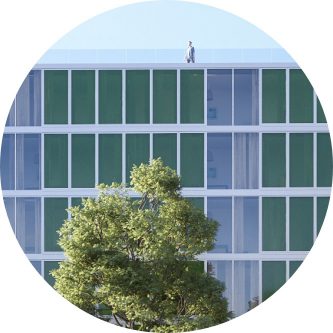When it comes to truly building sustainably, striving for energy efficiency, economic viability and convenience of use alone won’t fit the bill. One also needs to take into account the softer aspects of usability, such as the quality of design, to get buy-in from those using it. A marriage of Design and functionality, the bioenergy facade can be tailored to suit custom needs around facade type, size and material – and as such, allowing it to be smoothly embedded into any existing structure or environment.

The bioenergy facade not only offers impressive sound isolation capabilities of up to 50dB – it does so whilst offering flexibility around existing or desired window and door combinations.

The elements of the facade double as a sun protection and their orientation may be automated to the unique protective requirements, offering optimal convenience, whilst maintaining aesthetic quality.

A generous glass panel facade no longer disadvantages a building’s energy saving regulation ranking thanks to the bioenergy facade’s high thermal isolation capabilities.
As a primary facade, the bioenergy facade is a non-supporting frame (cladding) in tune with the existing windows and door structure. We offer various design options to choose from:
Translucent – in soothing green, but translucent color, visible from both the inside and outside
Opaque – the green color visible from the outside, but offering a transparent view from the inside
Transparent – a clear vision, from both the inside and the outside
As a secondary facade it forms an outer shell to the external wall. Whilst the distance between building wall and facade is predefined, you can custom define it to your needs, when opting for the opaque version.
For safety reasons, laminated glass is used for the glass layer exposed to the elements. We recommend additionally using a coating with anti reflective capabilities to avoid glaring, as well as to increase the efficiency of heat production and biomass by up to 20%.
The frame construction is adapted to the demands of the building with respect to noise insulation, fire protection and field size. The material and colour is variable: steel, aluminium, wood and plastic.
The bioenergy facade allows a variety of applications. Executions as an element façade or post-bar system both are possible without problems. The glass elements are compatible with standard profiles and can be thus combined with windows and doors to a consistent
outer wall.
The standard size of a bioenergy façade covers the full height between floors with a maximum in height and length of the glass panel of 3 and 1,3 m, respectively. In addition there is a stand of about 20 cm, which holds the tubes for circulation of water and pressured air.
Element facades consist of single elements – each of story height – which have been precast in factory and are embedded into the shell onsite, to complete the building framework. They are especially suited for large-scale, uniformly designed facades and can, if precast accordingly, be installed without the use of scaffolding. Further, cellparc offers integration of all parts required for the facade’s functionality at factory stage, if so desired.
A post bar system is applied to cover great installation height and track width. By variable dimensions of the profiles specially in depth and by using different materials the construction can be adapted to any installation situation, especially if different materials for the infill are chosen. The modular construction of a post-bar system allows both a prefabrication of the elements in the factory and a conjunction at the building lot.